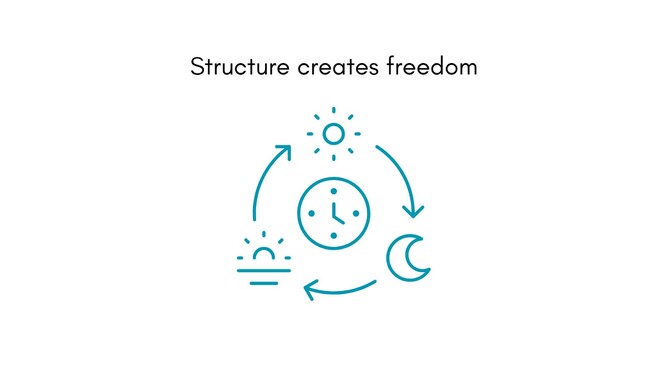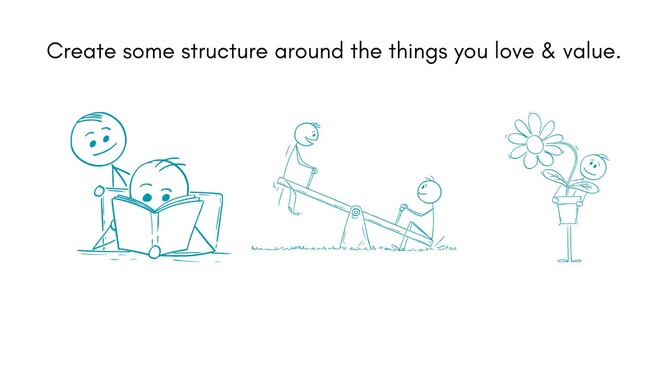For most of us, it starts well before we become aware of it: We live our lives in some sort of structure. Our parents structure our days, later daycare, primary and high school have specific structures and if we were involved in any after-school activities, they usually happened at particular times and in certain locations. So from a young age, many of us operate in some kind of structure.
You have probably had moments where you wanted to rebel against one of those. Maybe you stayed out longer than you were supposed to, spoke when you weren’t meant to, didn’t complete something that you were expected to do… And if you didn’t, you likely thought about doing it. In short, you were checking out how firm the boundaries of those structures really were.
Structure is interesting because, while it sometimes gets the reputation to be boring or mundane, or even limiting, I think structure creates freedom^. That’s right:
Structure creates freedom.
Let me explain: Anything you wrap into a structure, you don’t have to think about anymore. You might refer to your structures as routines, habits, rituals, or schedules. Whatever you call it, I’d encourage you to be deliberate about it. As an adult, you have more influence on what structures you follow, which ones you will implement yourself and which ones you will discard, ignore or reject. (Note: some of you might prefer ‘structure creates flexibility’ - go with whatever you prefer.)
Start with a simple stock-take. What structures (routines/habits/etc.) do you have in place already? Many of us have structures around waking up and getting ready and winding down, going to bed. So you might have a particular order in which you go through getting up, getting dressed, brushing your teeth, having breakfast, planning your day, etc. Take a second to reflect on what you do to start your day and also a bit of time to think about how you end your day. Again, do you follow a particular structure? And if you do, why this order, why these actions? Sometimes we just do what we have always done because that is what we did when we were kids.
Does that still serve you? Or could your structure do with an update?
There are lots of things we can tie into a structure. I, for example, know that I feel much better if I exercise. I also know that if I leave exercise to chance, it won’t happen. And as the days progress, I will get increasingly frustrated and grumpy. So my weekly exercise is tied up in pretty firm routines. During the week, I move every day, usually before breakfast, even if it is just a short walk. I have a few exercise-related things locked weekly. At the moment that’s a mixture of pilates classes and gym sessions. I say ‘at the moment’ because what I do, specifically, changes, but the fact that I have it locked in a structure does not.
Putting some structure around the things that matter to you means you don’t have to think about them much. They will happen. This frees you up to think about other, more important things.
To feel good, I also need at least one good conversation a day; a conversation that moves beyond small talk about the weather, the traffic or the increased cost of vegetables. Don’t get me wrong, I’m happy to start there, but for a conversation to be energising to me, it needs to go a bit deeper. I work with a bunch of interesting and curious people, so I’ll have lots of good conversations, but I also need to chat with people close to me. I live reasonably far away from most of them, so I have a few routines around calling people at similar times each week.
There are other things people tie into structures. Many do some meal planning and prep at the start of the week (or the end of the previous week) and that is super helpful. I’ll admit, I am not very good at food-related planning in particular, but when I do it, I’m always glad I did it. Because, again, it frees up brain space for me to think about other things. Blog writing for example.
Besides daily structures, you can also use weekly structures. Many high performers plan their week at the end of the previous week. The first thing they schedule is the time to review at the end of the week and plan the next. Taking 30 min at the end of each week to review how the week went and what you have on the following week is half an hour well spent on being deliberate about what you want and need.
I guess that is a key element to touch on: establishing a structure that works for you depends on what you need. Reflect on what you need to feel well, or what you need to do to make progress on something you care about. For me, I need a few things daily to feel well: exercise, enough water, decent food, one good conversation and decent sleep are probably my top 5. I also want to make progress with some of my written work, and for that, I need to write. So daily writing & weekly time to edit get wrapped into some structure alongside the other things.
If you are a leader (say a coach, teacher, people leader, manager, etc.), structure can serve several additional purposes. Establishing structures for the people you are looking after creates predictability. And predictability creates a sense of safety because people can anticipate what will happen. So if you always have your meetings at the same time and they usually follow a similar structure, your people know what is coming. Same with coaching sports teams and teaching classes, if your sessions and lessons follow some kind of structure, it keeps things predictable, which adds an element of safety. This doesn't mean you can never change it...
If, in contrast, you call your meetings randomly and last minute, people don’t get a heads up about what you expect of them when, and your approach seems unstructured, this will likely feel less safe. It also gets frustrating very quickly because people can feel at the mercy of your moods and ad hoc decisions, and they’ll feel like they are not in control of their time, all of which keep them from showing up and performing at their best.
The real bonus of establishing predictable structures as a leader to me though is that it frees you up. It might take some time and energy to set up the structure and to set expectations initially, but once you have established it, your people can run the structure (adults & kids). You don’t need to run the meeting, session or lesson, or at the very least not all of it, because your people have learned what to do when. This leaves you and them with more capacity to think and do what really matters (the work as opposed to the meeting about the work), rather than worry about how, when and where you will talk to each other and whether it will feel safe. It also enables your people to lead, to practise taking on some responsibility to run things their way, within your structure, if you let them and if you don’t micromanage… So using some structure in your leadership can empower your people.
As Gandhi told us,
‘The sign of a good leader is not how many followers you have, but how many leaders you create.’
If you are not a leader, and you feel like there aren’t enough structures in place for you to work well, can you ask for more structure?
As have alluded to already, sometimes structures have run their course and they need replacing or changing. And as always, there are times and days when I don’t fully follow my own structures because days have played out differently, I’m on holiday or I’m staying at someone’s house, etc. What remains at the core though, is that I am aware of what my usual structure is and I’m aware of what I need to feel well and positive in a day or a week. That doesn’t change much. So when I have days when I can’t use my normal structure or routine, I still know what I want in my day and I’ll make it happen.
Thank you for taking the time to read about how structure creates freedom. I appreciate it and I hope it has made you think. Please share it if you think someone else might find this useful.
Key points:
Establishing strong structures frees you up to focus, think deeply and make decisions about more important things.
Once established, structures become automated and you don’t have to think about them anymore, until you want to change them.
If you are a leader, implementing structures frees you up to focus on what is really important, creates a sense of safety and predictability for your people and enables your people to take on more responsibilities.
Reflection Questions:
What structures do you have in place right now? Why?
What do you need to feel well and /or make progress on something you care about? What daily/weekly structures could you wrap this in?
If you are a leader, what structures have you set up for your people? Do they free you up and enable your people to act? If not, how could you adjust/what structures could you establish to allow for that?
^ I first came across this phrase a podcast called ‘Talking Performance’ where one of his guests mentioned it in the context of youth coaching.





